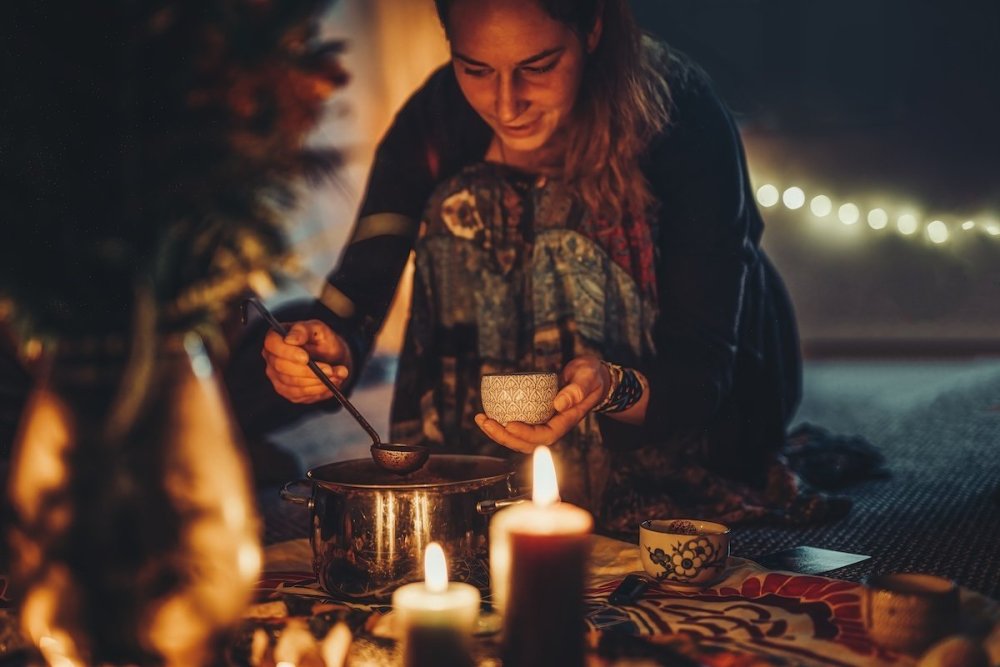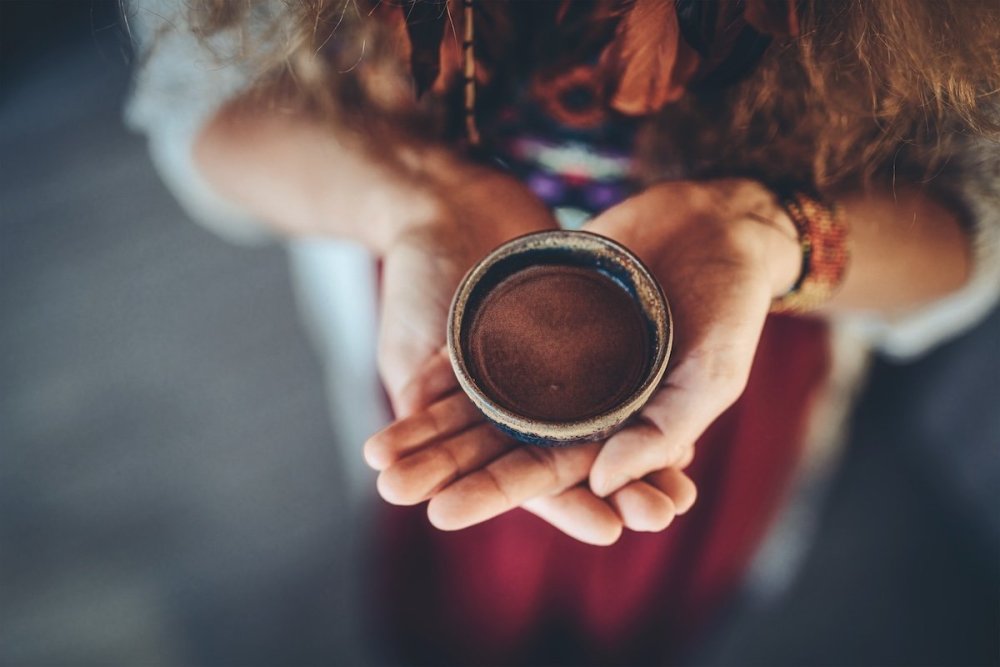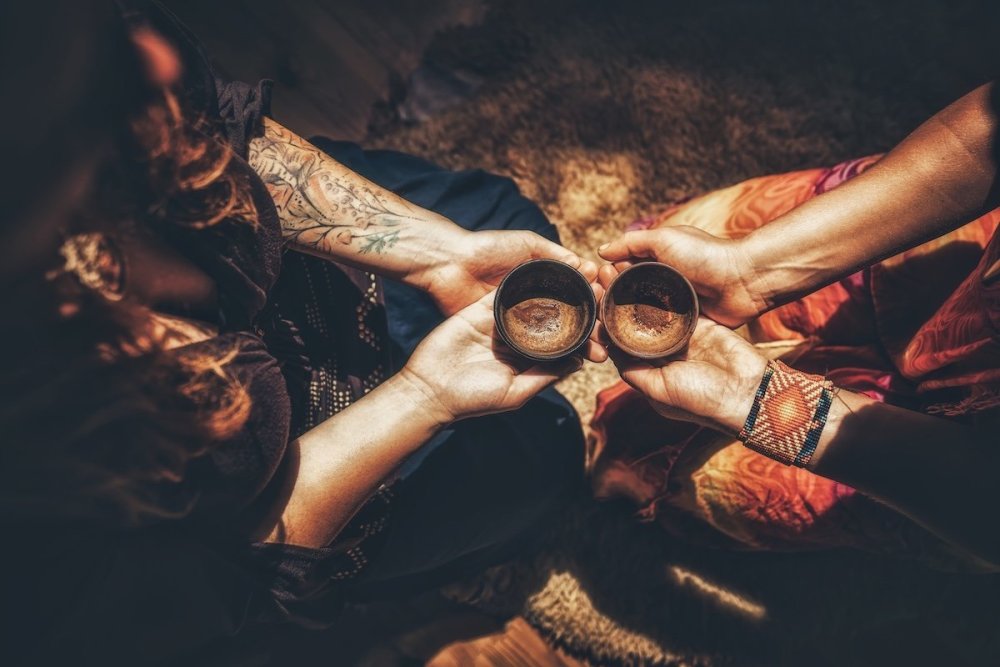Curious about cacao? Cacao ceremonies are grounded in intention and can benefit the mind, body, emotions, and spirit. Rhianna Quanstrom explores the power of ceremonial cacao and the history of this ancient practice.
Gathered in a circle with a steaming cup of cacao, you enter a transformative experience. The cacao opens your heart and elevates your mind, helping you connect with those around you and to the light within. A cacao ceremony is grounded in intention, and with it come many benefits.
Ceremonial cacao benefits all aspects of self, including the spiritual, physical, mental, and emotional. To better understand these benefits, let’s dive into what a cacao ceremony is, including its history, what cacao is, what you can expect during a ceremony, and how you can participate in one yourself.
What is a Cacao Ceremony?
A cacao ceremony is typically a communal gathering where people come together to receive the medicine of cacao. At its root, it is a spiritual experience that opens the heart and brings people together in harmony.
Every cacao ceremony is unique, and traditional ceremonies can differ significantly from modern Western ceremonies. In both settings, there's usually a guide or shaman who leads the ceremony and directs the flow of activities.
A cacao ceremony is not limited to a group setting and can be performed by individuals in their home. In essence, it's about receiving the medicine of cacao, which is ultimately a deeply personal experience.
Cacao Ceremony History
Cacao is deeply rooted in ancient (and modern) Mesoamerican cultures and history. Its use as a ceremonial plant dates back to the Aztecs and Mayans, who revered it as the “food of the gods.” They used cacao in spiritual ceremonies and rituals to unite the community and to honor important life initiations.
For example, it was used in ceremonies for births, marriages, baptisms, and funerals. It was also used regularly by the temple leaders as an aid in communing with the Divine. Interestingly, it played an important role in sacrifices to the gods.

Candles help create an intentional atmosphere during a cacao ceremony
Cacao was sacred to these people and was woven into their culture, mythology, healing practices, and spiritual traditions. As such, their ceremonies held a more religious focus, with cacao serving as a vessel for honoring and communicating with their deities.
In Western cultures today, cacao is not used in the same religious ways, though it remains a deeply spiritual experience when used with intention. Its history and cultural significance, however, should still be honored and respected.
When participating in a cacao ceremony, it is respectful to acknowledge its origins and the people who have held this wisdom for centuries. As such, this wisdom helps us distinguish what ceremonial cacao is compared to modern chocolate.
What is Ceremonial Cacao Exactly?
Ceremonial cacao is quite different from the chocolate we know (and love!). Their differences lie in how they are processed and used.
High-quality ceremonial cacao comes from native cacao plants in Central and South America. The beans are harvested from these native (and sometimes wild) plants before being minimally processed for consumption.
“Ceremonial cacao benefits the mind, emotions, body, and spirit. Both the cacao itself and the community have been shown to improve one’s well-being.”
The beans are first fermented and sun-dried, then sometimes lightly roasted before being stone-ground into a paste. This process retains cacao's natural compounds, which are highly beneficial for the body, making cacao a modern-day “superfood.” Furthermore, the cacao butter and solids are not separated in this phase, which is common for modern chocolate.
The cacao paste is then simmered in hot water to make the thick beverage used for ceremonies. This drink doesn’t taste like a normal hot chocolate; it's much more bitter and earthy tasting.
To enhance its flavor and potency, spices, natural sweeteners, and milk are sometimes added to the simmering cacao. For instance, a pinch of cayenne may be used to help “activate” cacao’s medicinal and spiritual properties.

The cacao used in ceremonies is bitter and earthy tasting
In contrast, modern chocolate is moderately to highly processed and is usually made from hybrid cacao varieties grown on large-scale monoculture farms. It's processed differently from ceremonial cacao and does not retain the same level of nutrients. Moreover, chocolate is enjoyed as a sweet treat, whereas ceremonial cacao is consumed with intention as a plant medicine supporting one’s spiritual, emotional, and physical well-being.
What Happens During a Cacao Ceremony?
As mentioned above, every cacao ceremony is slightly different depending on the guide and setting. Even so, you can expect an intentional atmosphere — perhaps with cushions on the ground, candles, incense, or crystals — whether outside or inside.
Once the participants of the ceremony have settled, the facilitator opens the space with welcoming words. During this phase, there may be discussion about the history and traditional uses of cacao. Each participant may be invited to set an intention for the ceremony, either inwardly or aloud.
After the space is set, the cacao is served. The participants are invited to sit with the energy of the beverage, hold it to their heart, and drink the warm, thick liquid slowly.
MORE LIKE THIS:
- Exploring Shamanic Healing: What to Expect
- Psychedelic Integration
- What is Ego Death? Meaning, Symptoms and Causes
Once the cacao is finished, the ceremony moves into other activities, and it's here that they can vary greatly. There is typically some sort of movement, such as dance or yoga, conscious breathwork, and meditation. There can also be sound healing (crystal singing bowls, gongs, etc.), group sharing, or creative expression through song, art, or writing.
While the outward activities unfold, you may notice a shift occurring within. Cacao naturally increases blood flow and softly opens the heart. You may feel emotions stirring and an easeful receptiveness towards those around you. When the heart softens and opens, love flows more freely and gracefully, and this is the energy that surrounds the sacred cacao ceremony.
The Benefits of a Ceremonial Cacao Benefits
Along with the love that holds the group together, ceremonial cacao benefits the mind, emotions, body, and spirit. Both the cacao itself and the community have been shown to improve one’s well-being.
1. Physical Benefits
Research by the National Library of Medicine confirms that cacao is rich in nutrients and antioxidants, which help prevent and combat oxidative stress. The numerous flavonoids (plant compounds) in cacao have also been shown to improve cardiovascular health, reduce cholesterol levels, regulate inflammation, and support metabolism.
Furthermore, cacao contains theobromine, which is a gentle stimulant that increases blood flow. This is what contributes to the heart-opening experience in the cacao ceremony.
2. Mental Benefits
The compound theobromine also increases blood flow and oxygenation to the mind, enhancing clarity, focus, and memory. Another study by the National Library of Medicine found that cocoa-rich products improved participants' moods while lowering depression and anxiety.
In addition, the practices woven into a cacao ceremony, such as meditation, movement, and breathwork, support mental calm and elevate one’s mood and happiness.
3. Emotional Benefits
Energetically, cacao softens and opens the heart. While studies show the physical effects of this, there are also the emotional/energetic effects. When one’s heart opens and softens, emotions can move more freely. Whatever is just beneath the surface can start to rise, which is why it’s normal for emotions to become heightened during a cacao ceremony. It is simply energy moving.
“Ceremonial cacao benefits the mind, emotions, body, and spirit. Both the cacao itself and the community have been shown to improve one’s well-being.”
Because of cacao’s mood-boosting properties and the energy of the group container, there are typically feelings of joy and happiness during the ceremony. However, there can also be grief, sadness, or anger that rises to the surface for release. In essence, a cacao ceremony creates a safe space for emotional expression, helping one feel lighter and clearer.
4. Spiritual Benefits
With the support of the community and cacao’s physical, mental, and emotional effects, one’s energy begins to harmonize. This allows for a deeper connection to self and the light within. This is amplified with the guided meditation and intentional movement that most ceremonies include.
When one’s heart and mind are open and receptive, inner wisdom can more easily reveal itself to our consciousness. As such, there is a high possibility for one to leave a cacao ceremony with clarity on their path forward, insight into their healing journey, or peace with the feeling of being at home within themselves.

The community of ceremonies brings people together
Can I Do My Own Cacao Ceremony?
It's possible. One can lead a self-guided ceremony and experience the profound healing, clarity, and sacredness of cacao in the comfort of their own home. However, if you’ve never participated in a guided ceremony, we highly recommend starting with a group cacao ceremony.
When people gather together with the same intention and focus, the energy — and the potential for healing and insight — is amplified. Plus, you'll have the experience of working with cacao with a guide before doing it on your own.
RELATED:
- What is the Peyote Cactus and Is It Legal?
- Microdosing 101: A Modern Phenomenon Rooted in Ancient Times
- What is Huachuma, the San Pedro Cactus?
If you’re interested in ceremonial cacao training, we recommend checking out local or online training. Ceremonial cacao training will equip you with the knowledge and confidence to lead a group and help others experience the transformational healing available in a cacao ceremony.
Takeaway: Ceremonial Cacao
A cacao ceremony is a powerful, unifying experience that is all about connection — connection to self, community, and the spirit of cacao. With its gentle, heart-opening effects, a cacao ceremony helps one deepen into the love within and to the love of those around them.
Along with cacao’s superfood benefits, it's a sacred plant long revered by the people who tend it. It should be treated with respect, and its ancient history should be remembered and honored with each sip. More than just a beverage, cacao is a bridge that connects us to a tradition of seeking the light within and connecting with the harmony of love.
Whether you join a group, create an at-home ritual, or begin ceremonial cacao training, you can experience the healing, clarity, and sense of purpose that working with cacao has to offer. ●
Images: shutterstock/Jozef Klopaca, shutterstock/Jozef Klopaca, shutterstock/Jozef Klopaca
happiness.com | The fine art of being: learn, practise, share
Are you a happiness.com member yet? Sign up for free to:
■ enjoy our happiness magazine with practical life tips
■ share and support in our happiness forum
Written by Rhianna Quanstrom
 Rhianna Quanstrom is a freelance writer, herbalist, and spiritual seeker with a passion for nature-based healing and sacred wisdom. Her writing draws from years of experience with meditation, shamanic practices, plant medicine, dream work, and the reclamation of the Sacred Feminine. Discover more of her writing and poetry on her Mystic Love Substack.
Rhianna Quanstrom is a freelance writer, herbalist, and spiritual seeker with a passion for nature-based healing and sacred wisdom. Her writing draws from years of experience with meditation, shamanic practices, plant medicine, dream work, and the reclamation of the Sacred Feminine. Discover more of her writing and poetry on her Mystic Love Substack.




Join the conversation
You are posting as a guest. If you have an account, sign in now to post with your account.
There are no comments to display.